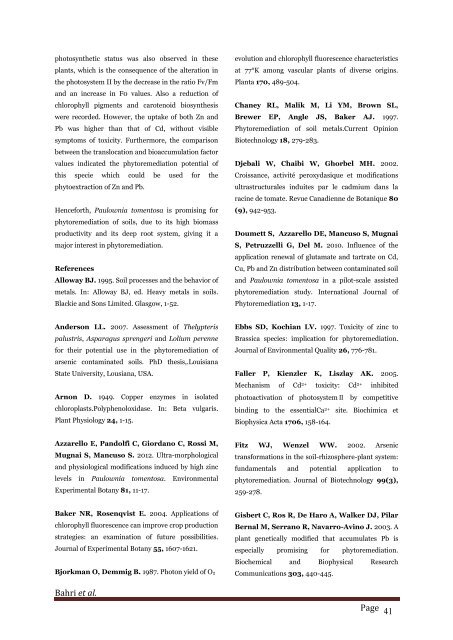Growth performance, photosynthetic status and bioaccumulation of heavy metals by Paulownia tomentosa (Thunb.) Steud growing on contaminated soils
Abstract This work focuses on the study of the potential of a woody specie Paulownia tomentosa (Thunb.) Steud in the phytoremediation of soils polluted by heavy metals. Total metal concentrations in soil samples as well as their bioaccumulation in plant tissues were performed by Atomic Absorption Spectrometry. Bioaccumulation factors (BF) and translocation factors (TF) were calculated in order to determine the effectiveness of plants in removing heavy metals from soil. Results showed that heavy metals significantly affected the root biomass production compared to the leaf biomass and caused slight reductions in all growth parameters. However, the presence of high amounts of ETM in polluted substratum restricted the synthesis of chlorophyll pigments and lead to the deterioration of photosynthetic parameters. Zn, Pb and Cd were found in plant shoots and roots at different levels, between 5.083 and 205.33 mg kg-1 DMW for Zn, 23.22 and 50.13 mg kg-1 DM for Pb and between 0 and 3.88 mg kg-1 DMW for Cd. Translocation and bioaccumulation factors indicated that Paulownia tomentosa could be used in the phytoextraction of Zn and Pb.
Abstract
This work focuses on the study of the potential of a woody specie Paulownia tomentosa (Thunb.) Steud in the phytoremediation of soils polluted by heavy metals. Total metal concentrations in soil samples as well as their bioaccumulation in plant tissues were performed by Atomic Absorption Spectrometry. Bioaccumulation factors (BF) and translocation factors (TF) were calculated in order to determine the effectiveness of plants in removing
heavy metals from soil. Results showed that heavy metals significantly affected the root biomass production compared to the leaf biomass and caused slight reductions in all growth parameters. However, the presence of
high amounts of ETM in polluted substratum restricted the synthesis of chlorophyll pigments and lead to the deterioration of photosynthetic parameters. Zn, Pb and Cd were found in plant shoots and roots at different
levels, between 5.083 and 205.33 mg kg-1 DMW for Zn, 23.22 and 50.13 mg kg-1 DM for Pb and between 0 and 3.88 mg kg-1 DMW for Cd. Translocation and bioaccumulation factors indicated that Paulownia tomentosa could
be used in the phytoextraction of Zn and Pb.
You also want an ePaper? Increase the reach of your titles
YUMPU automatically turns print PDFs into web optimized ePapers that Google loves.
<str<strong>on</strong>g>photosynthetic</str<strong>on</strong>g> <str<strong>on</strong>g>status</str<strong>on</strong>g> was also observed in these<br />
plants, which is the c<strong>on</strong>sequence <str<strong>on</strong>g>of</str<strong>on</strong>g> the alterati<strong>on</strong> in<br />
the photosystem II <str<strong>on</strong>g>by</str<strong>on</strong>g> the decrease in the ratio Fv/Fm<br />
<str<strong>on</strong>g>and</str<strong>on</strong>g> an increase in F0 values. Also a reducti<strong>on</strong> <str<strong>on</strong>g>of</str<strong>on</strong>g><br />
chlorophyll pigments <str<strong>on</strong>g>and</str<strong>on</strong>g> carotenoid biosynthesis<br />
were recorded. However, the uptake <str<strong>on</strong>g>of</str<strong>on</strong>g> both Zn <str<strong>on</strong>g>and</str<strong>on</strong>g><br />
Pb was higher than that <str<strong>on</strong>g>of</str<strong>on</strong>g> Cd, without visible<br />
symptoms <str<strong>on</strong>g>of</str<strong>on</strong>g> toxicity. Furthermore, the comparis<strong>on</strong><br />
between the translocati<strong>on</strong> <str<strong>on</strong>g>and</str<strong>on</strong>g> <str<strong>on</strong>g>bioaccumulati<strong>on</strong></str<strong>on</strong>g> factor<br />
values indicated the phytoremediati<strong>on</strong> potential <str<strong>on</strong>g>of</str<strong>on</strong>g><br />
this specie which could be used for the<br />
phytoextracti<strong>on</strong> <str<strong>on</strong>g>of</str<strong>on</strong>g> Zn <str<strong>on</strong>g>and</str<strong>on</strong>g> Pb.<br />
Henceforth, <str<strong>on</strong>g>Paulownia</str<strong>on</strong>g> <str<strong>on</strong>g>tomentosa</str<strong>on</strong>g> is promising for<br />
phytoremediati<strong>on</strong> <str<strong>on</strong>g>of</str<strong>on</strong>g> <strong>soils</strong>, due to its high biomass<br />
productivity <str<strong>on</strong>g>and</str<strong>on</strong>g> its deep root system, giving it a<br />
major interest in phytoremediati<strong>on</strong>.<br />
References<br />
Alloway BJ. 1995. Soil processes <str<strong>on</strong>g>and</str<strong>on</strong>g> the behavior <str<strong>on</strong>g>of</str<strong>on</strong>g><br />
<str<strong>on</strong>g>metals</str<strong>on</strong>g>. In: Alloway BJ, ed. Heavy <str<strong>on</strong>g>metals</str<strong>on</strong>g> in <strong>soils</strong>.<br />
Blackie <str<strong>on</strong>g>and</str<strong>on</strong>g> S<strong>on</strong>s Limited. Glasgow, 1-52.<br />
evoluti<strong>on</strong> <str<strong>on</strong>g>and</str<strong>on</strong>g> chlorophyll fluorescence characteristics<br />
at 77°K am<strong>on</strong>g vascular plants <str<strong>on</strong>g>of</str<strong>on</strong>g> diverse origins.<br />
Planta 170, 489-504.<br />
Chaney RL, Malik M, Li YM, Brown SL,<br />
Brewer EP, Angle JS, Baker AJ. 1997.<br />
Phytoremediati<strong>on</strong> <str<strong>on</strong>g>of</str<strong>on</strong>g> soil <str<strong>on</strong>g>metals</str<strong>on</strong>g>.Current Opini<strong>on</strong><br />
Biotechnology 18, 279-283.<br />
Djebali W, Chaibi W, Ghorbel MH. 2002.<br />
Croissance, activité peroxydasique et modificati<strong>on</strong>s<br />
ultrastructurales induites par le cadmium dans la<br />
racine de tomate. Revue Canadienne de Botanique 80<br />
(9), 942-953.<br />
Doumett S, Azzarello DE, Mancuso S, Mugnai<br />
S, Petruzzelli G, Del M. 2010. Influence <str<strong>on</strong>g>of</str<strong>on</strong>g> the<br />
applicati<strong>on</strong> renewal <str<strong>on</strong>g>of</str<strong>on</strong>g> glutamate <str<strong>on</strong>g>and</str<strong>on</strong>g> tartrate <strong>on</strong> Cd,<br />
Cu, Pb <str<strong>on</strong>g>and</str<strong>on</strong>g> Zn distributi<strong>on</strong> between c<strong>on</strong>taminated soil<br />
<str<strong>on</strong>g>and</str<strong>on</strong>g> <str<strong>on</strong>g>Paulownia</str<strong>on</strong>g> <str<strong>on</strong>g>tomentosa</str<strong>on</strong>g> in a pilot-scale assisted<br />
phytoremediati<strong>on</strong> study. Internati<strong>on</strong>al Journal <str<strong>on</strong>g>of</str<strong>on</strong>g><br />
Phytoremediati<strong>on</strong> 13, 1-17.<br />
Anders<strong>on</strong> LL. 2007. Assessment <str<strong>on</strong>g>of</str<strong>on</strong>g> Thelypteris<br />
palustris, Asparagus sprengeri <str<strong>on</strong>g>and</str<strong>on</strong>g> Lolium perenne<br />
for their potential use in the phytoremediati<strong>on</strong> <str<strong>on</strong>g>of</str<strong>on</strong>g><br />
arsenic c<strong>on</strong>taminated <strong>soils</strong>. PhD thesis,.Louisiana<br />
State University, Lousiana, USA.<br />
Arn<strong>on</strong> D. 1949. Copper enzymes in isolated<br />
chloroplasts.Polyphenoloxidase. In: Beta vulgaris.<br />
Plant Physiology 24, 1-15.<br />
Ebbs SD, Kochian LV. 1997. Toxicity <str<strong>on</strong>g>of</str<strong>on</strong>g> zinc to<br />
Brassica species: implicati<strong>on</strong> for phytoremediati<strong>on</strong>.<br />
Journal <str<strong>on</strong>g>of</str<strong>on</strong>g> Envir<strong>on</strong>mental Quality 26, 776-781.<br />
Faller P, Kienzler K, Liszlay AK. 2005.<br />
Mechanism <str<strong>on</strong>g>of</str<strong>on</strong>g> Cd 2+ toxicity: Cd 2+ inhibited<br />
photoactivati<strong>on</strong> <str<strong>on</strong>g>of</str<strong>on</strong>g> photosystemⅡ <str<strong>on</strong>g>by</str<strong>on</strong>g> competitive<br />
binding to the essentialCa 2+ site. Biochimica et<br />
Biophysica Acta 1706, 158-164.<br />
Azzarello E, P<str<strong>on</strong>g>and</str<strong>on</strong>g>olfi C, Giordano C, Rossi M,<br />
Mugnai S, Mancuso S. 2012. Ultra-morphological<br />
<str<strong>on</strong>g>and</str<strong>on</strong>g> physiological modificati<strong>on</strong>s induced <str<strong>on</strong>g>by</str<strong>on</strong>g> high zinc<br />
levels in <str<strong>on</strong>g>Paulownia</str<strong>on</strong>g> <str<strong>on</strong>g>tomentosa</str<strong>on</strong>g>. Envir<strong>on</strong>mental<br />
Experimental Botany 81, 11-17.<br />
Fitz WJ, Wenzel WW. 2002. Arsenic<br />
transformati<strong>on</strong>s in the soil-rhizosphere-plant system:<br />
fundamentals <str<strong>on</strong>g>and</str<strong>on</strong>g> potential applicati<strong>on</strong> to<br />
phytoremediati<strong>on</strong>. Journal <str<strong>on</strong>g>of</str<strong>on</strong>g> Biotechnology 99(3),<br />
259-278.<br />
Baker NR, Rosenqvist E. 2004. Applicati<strong>on</strong>s <str<strong>on</strong>g>of</str<strong>on</strong>g><br />
chlorophyll fluorescence can improve crop producti<strong>on</strong><br />
strategies: an examinati<strong>on</strong> <str<strong>on</strong>g>of</str<strong>on</strong>g> future possibilities.<br />
Journal <str<strong>on</strong>g>of</str<strong>on</strong>g> Experimental Botany 55, 1607-1621.<br />
Bjorkman O, Demmig B. 1987. Phot<strong>on</strong> yield <str<strong>on</strong>g>of</str<strong>on</strong>g> O2<br />
Gisbert C, Ros R, De Haro A, Walker DJ, Pilar<br />
Bernal M, Serrano R, Navarro-Avino J. 2003. A<br />
plant genetically modified that accumulates Pb is<br />
especially promising for phytoremediati<strong>on</strong>.<br />
Biochemical <str<strong>on</strong>g>and</str<strong>on</strong>g> Biophysical Research<br />
Communicati<strong>on</strong>s 303, 440-445.<br />
Bahri et al.<br />
Page 41





![Review on: impact of seed rates and method of sowing on yield and yield related traits of Teff [Eragrostis teff (Zucc.) Trotter] | IJAAR @yumpu](https://documents.yumpu.com/000/066/025/853/c0a2f1eefa2ed71422e741fbc2b37a5fd6200cb1/6b7767675149533469736965546e4c6a4e57325054773d3d/4f6e6531383245617a537a49397878747846574858513d3d.jpg?AWSAccessKeyId=AKIAICNEWSPSEKTJ5M3Q&Expires=1716832800&Signature=RMbusRkcNIpaTFb7IQvFGITqeKM%3D)












